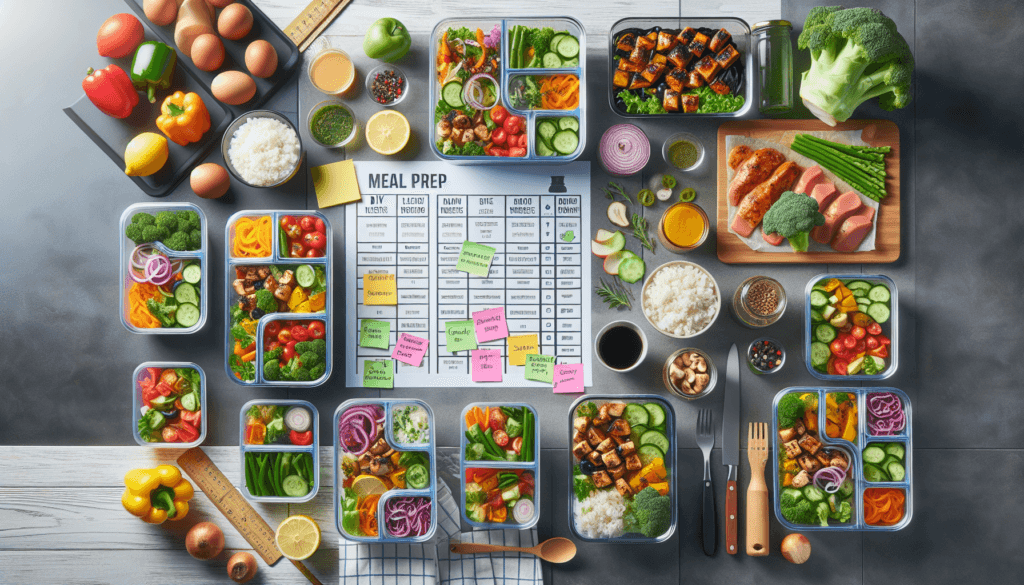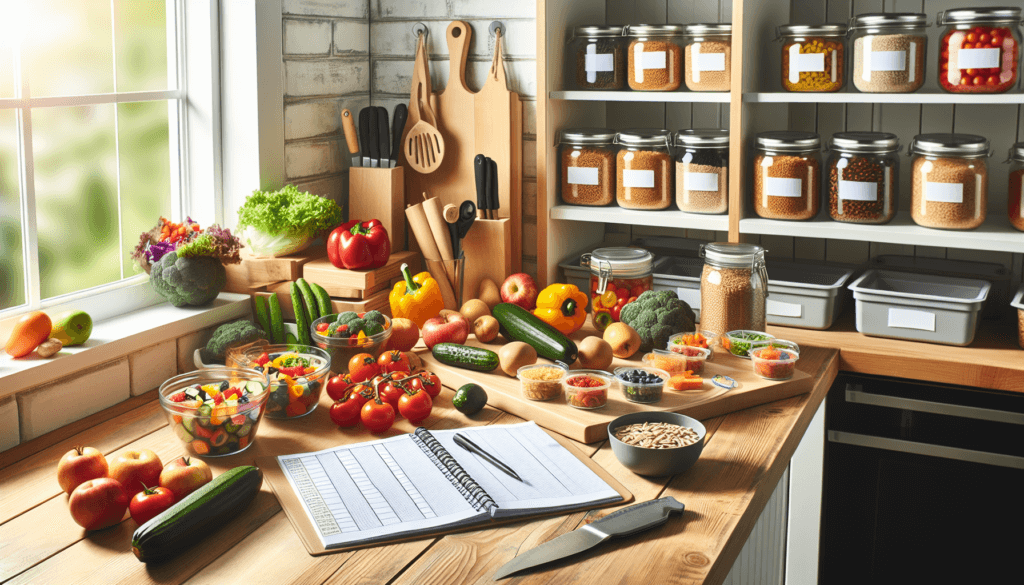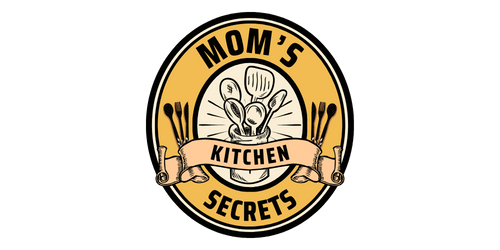You’ve decided it’s time to take control of your nutrition and start meal prepping like a pro. But where do you begin? In this ultimate guide, we’ll walk you through everything you need to know to become a master meal prepper. From planning and prepping your meals to choosing the right containers and storing your food, we’ve got you covered. Get ready to save time, money, and stress while enjoying delicious and nutritious meals all week long. It’s time to take your meal prep game to the next level!

Meal Planning Basics
Determining Your Goals
When it comes to meal planning, the first step is to determine your goals. Are you looking to lose weight, gain muscle, or simply maintain a healthy lifestyle? Knowing your goals will help you tailor your meal plan accordingly. Take some time to reflect on what you want to achieve and write down specific goals that are realistic and achievable.
Calculating Your Caloric Needs
To create an effective meal plan, it’s essential to calculate your daily caloric needs. This involves determining how many calories your body requires to function properly based on factors such as age, gender, weight, height, and activity level. There are numerous online calculators and apps available that can help you estimate your caloric needs accurately.
Choosing Your Meals and Recipes
Now that you have established your goals and determined your caloric needs, it’s time to choose the meals and recipes for your meal plan. Aim for a well-balanced diet that includes a variety of nutrient-dense foods such as lean proteins, whole grains, fruits, vegetables, and healthy fats. Look for recipes that align with your goals and suit your taste preferences. Don’t be afraid to experiment with different flavors and cuisines to keep your meals exciting and enjoyable.
Stocking Your Pantry and Fridge
Essential Pantry Staples
Stocking your pantry with essential staples is crucial for successful meal prep. Some pantry must-haves include whole grains like brown rice and quinoa, canned beans, cooking oils, herbs, spices, and condiments. These ingredients serve as the foundation of many recipes and provide the necessary flavor and nutrition to your meals. Keeping your pantry stocked ensures that you always have the basics to whip up a delicious and healthy meal.
Must-Have Refrigerator Items
In addition to a well-stocked pantry, having essential refrigerator items is key to meal prepping like a pro. Some must-haves include eggs, milk or plant-based alternatives, a variety of fresh fruits and vegetables, lean proteins such as chicken breast or tofu, and Greek yogurt. These items provide the building blocks for nutritious and satisfying meals and make it easier to create a balanced plate.
Organizing Your Kitchen
To streamline your meal prep process, it’s important to keep your kitchen organized. Clear out any expired or unused ingredients from your pantry and fridge. Invest in quality storage containers to keep your prepped ingredients and meals fresh. Arrange your pantry items in a way that makes them easily accessible, and label your containers for easy identification. Maintaining an organized kitchen will save you time and frustration when it comes to meal prepping.
Meal Prep Tools and Equipment
Meal Prep Containers
Investing in good quality meal prep containers is essential for efficient and convenient meal prep. Look for containers that are microwave-safe, dishwasher-safe, and leak-proof to ensure easy reheating, cleaning, and transportation. Consider purchasing containers in various sizes to accommodate different portion sizes and meal types. Glass or BPA-free plastic containers are both excellent choices for storing your prepped meals.
Kitchen Utensils and Gadgets
Having the right kitchen utensils and gadgets can greatly simplify your meal prep process. Some essential tools include a sharp knife, cutting board, measuring cups and spoons, mixing bowls, a blender or food processor, and a set of non-stick cookware. These tools will make chopping, measuring, and cooking a breeze and help you save time during meal prep.
Food Storage Options
In addition to meal prep containers, consider investing in other food storage options to keep your ingredients and prepped meals fresh. Mason jars are great for storing salads and overnight oats, while zip-top bags are perfect for freezing individual portions of soups and stews. Vacuum sealers are also handy for extending the shelf life of your ingredients and preventing freezer burn. Explore different food storage options and choose ones that best suit your needs and preferences.
Mastering Batch Cooking
Choosing the Right Recipes
Batch cooking involves preparing a large quantity of food at once to have ready-made meals and ingredients throughout the week. To master batch cooking, select recipes that are suitable for large portions and can be easily reheated without sacrificing taste or texture. Casseroles, stews, and stir-fries are great options for batch cooking as they tend to improve in flavor over time.
Efficient Ingredient Prep
Efficient ingredient prep is the key to successful batch cooking. Set aside a dedicated time each week to chop vegetables, marinate proteins, and prepare grains or legumes. Pre-portion your ingredients into containers or bags based on your recipes, so they are ready to be used when it’s time to cook. This will save you precious time and make the cooking process much smoother.
Cooking in Batches
When it’s time to cook, make use of your batch cooking skills to prepare large quantities of meals. Invest in larger cookware or use multiple pots and pans simultaneously to maximize efficiency. Utilize your oven, slow cooker, or instant pot to cook large batches of proteins, grains, or soups. Once cooked, portion out your meals into containers for easy grab-and-go options throughout the week.

Prepping Fruits and Vegetables
Cleaning and Storing Produce
Properly cleaning and storing fruits and vegetables will help extend their freshness and preserve their nutritional value. Wash your produce thoroughly under running water to remove any dirt or pesticides. Pat them dry before storing in the fridge to prevent moisture-related spoilage. Some fruits and vegetables, like berries, benefit from being stored in airtight containers with paper towels to absorb excess moisture.
Cutting and Chopping Techniques
Mastering cutting and chopping techniques will save you time and ensure consistent results when prepping fruits and vegetables. Learn basic knife skills like julienne, dice, and mince to efficiently cut a wide variety of produce. Investing in a quality chef’s knife and cutting board will make the process easier and safer. Practice makes perfect, so don’t be afraid to experiment and improve your skills.
Preventing Browning and Spoilage
Certain fruits and vegetables, like avocados and apples, tend to brown quickly after being cut. To prevent browning, squeeze some lemon or lime juice over the exposed surface or submerge the produce in cold water with a dash of vinegar. Storing cut fruits and vegetables in airtight containers with a slice of onion can also help delay browning. Be mindful of proper storage temperatures and use your prepped produce within a reasonable timeframe to avoid spoilage.
Protein Prepping
Marinating and Seasoning Proteins
Marinating and seasoning proteins in advance can greatly enhance their flavor and tenderness. Experiment with different marinades using ingredients like citrus juices, herbs, spices, and soy sauce. Allow your proteins to marinate in the fridge for at least 30 minutes or overnight for maximum flavor infusion. Seasoning proteins with a dry rub or spice blend before cooking is another excellent way to add flavor and depth to your meals.
Grilling, Baking, or Roasting Techniques
Whether you prefer grilling, baking, or roasting, there are various techniques you can master for protein prepping. Grilling imparts a smoky flavor and delicious char to proteins like chicken, steak, or vegetables. Baking is perfect for lean cuts of meat or fish, while roasting is great for whole chickens or root vegetables. Experiment with different cooking methods and temperatures to find your preferred technique.
Portioning and Storing
After you’ve cooked your proteins, it’s important to portion and store them properly to maintain their quality. Divide your protein into individual portions using your meal prep containers or zip-top bags. Label them with the date and contents for easy identification. Refrigerate or freeze your portions based on your meal plan and use them within a few days or up to three months for optimal quality.

Carbohydrate Prepping
Cooking and Seasoning Grains
Carbohydrates such as grains are a staple in many meal prep recipes. Cooked grains like rice, quinoa, or pasta can be portioned and stored for quick and easy meals throughout the week. To add flavor, consider seasoning your grains with herbs, spices, or low-sodium broths while cooking. Experiment with different grains and cooking methods to incorporate variety into your meal plan.
Baking or Roasting Root Vegetables
Root vegetables like sweet potatoes, carrots, and beets are delicious and nutritious options for meal prepping carbohydrates. Baking or roasting these vegetables brings out their natural sweetness and enhances their texture. Peel, chop, and season your root vegetables with herbs and spices before roasting them in the oven. Once cooked, let them cool before portioning and storing them in your meal prep containers.
Portioning and Freezing
To ensure your prepped carbohydrates stay fresh and convenient, portion and freeze them if desired. Allow your cooked grains or roasted root vegetables to cool completely before transferring them to freezer-safe bags or containers. Label the bags with the date and contents and store them in the freezer for up to three months. When needed, simply thaw and reheat your portions for a quick and nutritious meal.
Grab-and-Go Breakfast Preps
Overnight Oats Variations
Overnight oats are a time-saving and nutritious option for busy mornings. Simply combine rolled oats, milk or yogurt, and your favorite toppings in a jar or container, and refrigerate overnight. In the morning, grab your container and enjoy cold or warm, or add some fresh fruit for extra flavor and texture. Experiment with different flavor combinations like chocolate and peanut butter or blueberry and almond.
Make-Ahead Smoothie Packs
Make-ahead smoothie packs are a convenient way to enjoy a healthy and delicious breakfast on the go. Pre-portion your favorite smoothie ingredients like fruits, leafy greens, and nuts into individual bags or containers. Freeze them, and when you’re ready to enjoy a smoothie, simply blend the contents with your choice of liquid. Customize your smoothie packs with different combinations to keep your breakfasts interesting.
Baked Egg Cups and Muffins
Baked egg cups and muffins are excellent options for protein-packed breakfasts that can be made in advance. Whisk together eggs, vegetables, and your choice of cheese or protein, then pour the mixture into greased muffin tins or ramekins. Bake until set and golden brown. Once cooled, these egg cups and muffins can be stored in the fridge or freezer and reheated in the microwave or oven for a quick and satisfying breakfast.

Lunch and Dinner Prep Ideas
Mason Jar Salads
Mason jar salads are not only visually appealing but also practical for meal prepping lunches. Layer your favorite salad ingredients, starting with the dressing at the bottom, followed by heavier ingredients like proteins, grains, or beans, and finishing with lighter ingredients like leafy greens and herbs. Seal the jars tightly and refrigerate until ready to eat. When it’s time for lunch, simply shake and pour the salad onto a plate or enjoy it straight from the jar.
Sheet Pan Meals
Sheet pan meals are a lifesaver when it comes to easy and efficient dinner prep. Simply arrange your protein, vegetables, and seasonings on a sheet pan, drizzle with some oil or sauce, and roast in the oven until everything is cooked through and caramelized. The best part is the minimal cleanup required, as everything is cooked on a single sheet pan. Experiment with different flavor combinations and spice blends to create a variety of sheet pan meals.
Freezer-Friendly Casseroles
Casseroles are a classic meal prep option that can be prepared in advance and stored in the freezer for future meals. Choose recipes that include a balance of protein, vegetables, and carbohydrates, like a chicken and vegetable casserole with quinoa or brown rice. After assembling the casserole, cover it tightly with foil or plastic wrap, then freeze. When you’re ready to enjoy the casserole, simply thaw and bake until heated through.
Meal Prep for Busy Lifestyles
Quick and Easy Recipes
For those with busy lifestyles, quick and easy recipes are a lifesaver. Look for recipes that require minimal prep time and utilize simple ingredients. One-pot meals like stir-fries or pasta dishes are great options as they minimize cleanup. Utilize your slow cooker or instant pot for hands-off cooking that results in delicious and convenient meals. Don’t forget to incorporate prepped ingredients to save even more time.
One-Pot and One-Pan Meals
Streamline your meal prep even further with one-pot and one-pan meals that require minimal cooking and cleanup. These recipes typically involve combining all the ingredients in a single pot or pan, then allowing them to cook together. Soups, stews, and skillet meals are excellent examples of these time-saving options. Experiment with different ingredients and seasonings to create a variety of flavorful one-pot and one-pan meals.
Prep-Ahead Freezer Meals
Prep-ahead freezer meals are a game-changer for busy individuals who want to have homemade meals readily available. Plan a designated day for meal prep, where you can dedicate a few hours to prepare and assemble multiple freezer-friendly meals. Choose recipes that can be easily frozen and reheated without sacrificing taste or texture. Casseroles, soups, and large batches of sauces or marinades are perfect for freezing. Label and organize your freezer meals for easy and stress-free cooking on busy days.
By following these meal prep basics and utilizing the various techniques and recipes shared in this guide, you can become a meal prep pro. Take the time to plan your meals, stock your pantry and fridge with essentials, and invest in the right tools and equipment. Master batch cooking, prepping fruits, vegetables, proteins, and carbohydrates. Explore grab-and-go breakfast ideas, lunch and dinner prep strategies, and meal prep options for busy lifestyles. With consistency and practice, you’ll soon find yourself saving time, money, and stress while enjoying delicious and nutritious meals throughout the week. Happy meal prepping!



